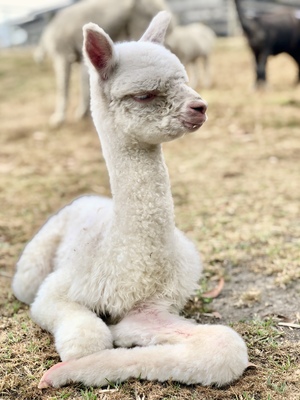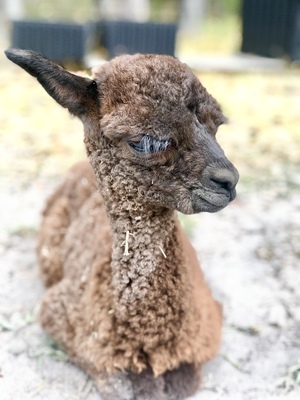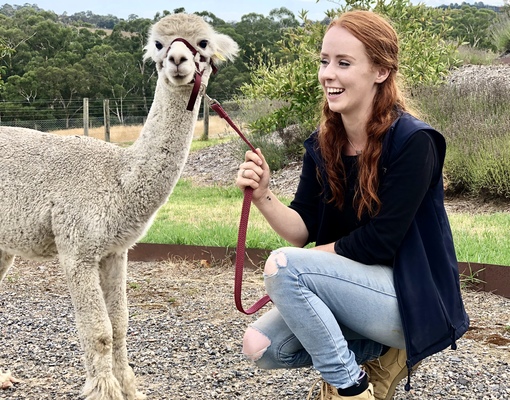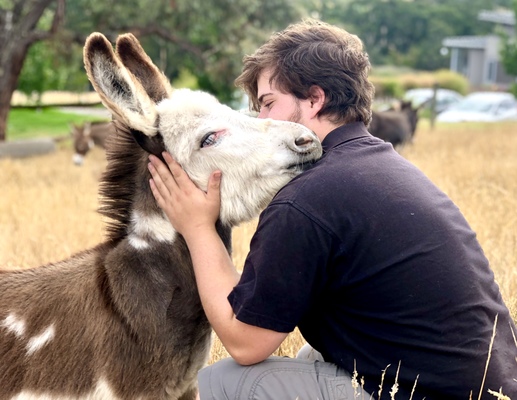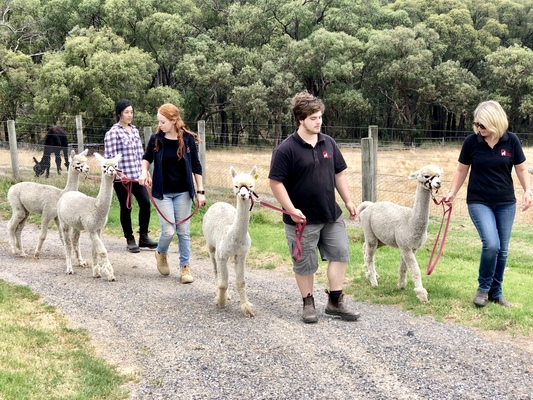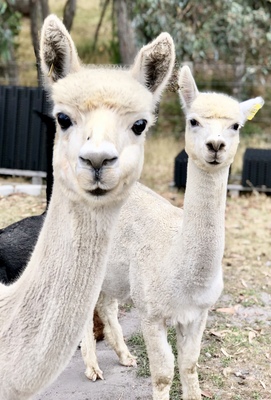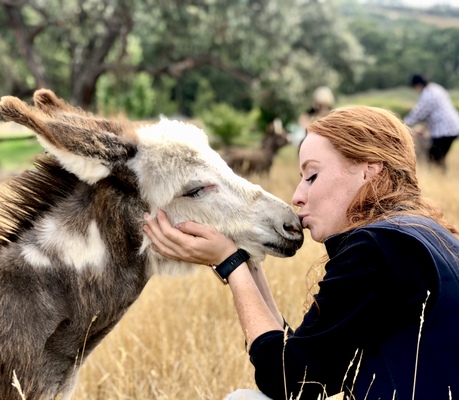
Lynda Holdsworth leans on a gate as she watches her herd of alpaca’s tuck into some hay. A sudden sneeze from one of the alpaca’s causes a creamy coloured cria (young alpaca) to jump. The youngster then hops over to his mother nearby, and begins feeding.
“I think he’s the prettiest one,” Lynda says. “He was born yesterday. His name is Don Quixote. I just like him; I think he’s very cute and has plenty of presence.”
Lynda runs the stud 20-acre farm, Auravale Alpacas, with her husband Nicholas and their 18-year-old youngest son William after moving from Malvern 10 years ago. They also have seven miniature donkeys as a hobby on (the) their property.
Rachel Burnett, 20, from the Victorian Alpaca Youth also assists as a farm-hand. “I couldn’t manage on my own, Rachel is a fabulous help.” says Lynda.
The rolling pastures at their Belgrave South farm provides a peaceful atmosphere for the Huacaya alpaca breed which Lynda says are gentle and relaxing to be around.
The Holdworth’s have “never looked back,” since their escape from the city. “I had my horse’s agisted on this property and I saw it up for sale one day, and so we just decided to move here – absolutely love it.”
Lynda smile broadens: “This is birthing season for us, 11 crias to date, five in the last 48 hours with another seven or so due in next couple of weeks.”
Ten years ago, she says her husband “gave me a present where we went and did an alpaca stay overnight at an alpaca farm and I really just fell in love with them.”
“Fairly quickly we built up a good herd; and now have well over a hundred.”
Lynda explains (the herd are usually out in the paddocks). “We do what’s called rotational grazing – the herd is rotated through a large number of paddocks on a routine basis, they are moved each week – providing the empty paddock 8-12 weeks to rest and restore.”
“This process helps to reduce the animals intestinal worm burdens and provides good rest periods for our pastures.”
Their alpacas are of different genders, ages and colours. She says they specialise in white and a few black alpacas but concedes “you get what you’re given.”
“The browns just come by default,” she laughs. “We don’t particularly breed for them. There’s (is) a science to it but it doesn’t always work.”
They sell their alpacas to people wanting to breed stud stock as well as hobby farmers. “As you could imagine this area has a lot of small holding hobby farmers, so there are a lot of people that love alpacas.”
A couple of alpacas eat hay inside a tyre on the ground, while one rolls in some dirt.
“They love a dust bath,” Lynda says. “They also like dams and water – they’ll be up to their waste on hot days.”
Auravale Alpacas is also listed as a provider for student work placements with Melbourne University.
Lynda introduces Alicia Nguyen who is studying a Doctor of Veterinary Medicine. Alicia says she’s grateful for the time she gets to work hands-on at the farm rather than being in class all day.
When asked about the alpaca’s personalities, Alicia says they are all different.
“I think some of them are very docile. They’ll come up to you and let you do what you want. Some of them are skittish – that comes with being a herd animal.”
Lynda says she enjoys teaching. “I don’t know how good a teacher I am… I’m really keen for the public to learn more about alpacas. If the students get an opportunity to work with them, I think that is broadening their knowledge and promoting the alpaca industry is great.“
Lynda speaks passionately of her alpacas: “I find it relaxing – most of the time unless things go wrong. They’re quiet, they don’t make a lot of noise, they’re pretty inquisitive, and they’re intelligent animals.”
She explains the paddocks are “quite dry” at this time of the year and the herd have just been given a mineral drench – a fast acting liquid supplement. “They’ve all come through; they’ve all been very good – they are used to it. There’s been no issues, no problems,” Lynda says.
“It’s breeding time so it’s just a matter of keeping an eye on them…there’s eleven little crias in here; there’s another seven still to come.”
Lynda points to a shed only a few metres away. “We have our treatment area all set up here. So once a month they all come in, they get weighed every month.
“If there’s anything to do for them, if they need their extra minerals or if they need their vitamin D injections, we provide all their ongoing care in this shed.”
She also says alpacas are easy on the environment. “They have soft, padded feet, they don’t have hoofs – so from an environmental point of view they’re a really good animal to have especially when you’ve got a small amount of land.”
The herd get on well as a group and are protective, says Lynda. “We’ve bred hundreds of alpacas and have never had an aggressive one.”
“They’re good at perceiving danger,” she explains. “There are quite a number of foxes around here and they are particularly protective when they have young cria at foot. They hate foxes. If there’s a strange dog that comes onto the property they’ll chase it too.”
Today, Lynda is preparing for the Berwick Show which will be held on 23-24 February where they will show 8-10 alpacas.
“From the age of six months we start putting a halter on them – get them used to the halter first; we use the pressure and release method of teaching them to walk.
The main features judges will look for are conformation and fineness, density, and low primary fibres of their fleece.
“We’ve won Supreme Huacaya alpaca at Berwick before, and quite a few championships. So we’re quite keen to be competitive. There is some excellent breeding in Victoria so there is plenty of competition.“ Lynda says.




